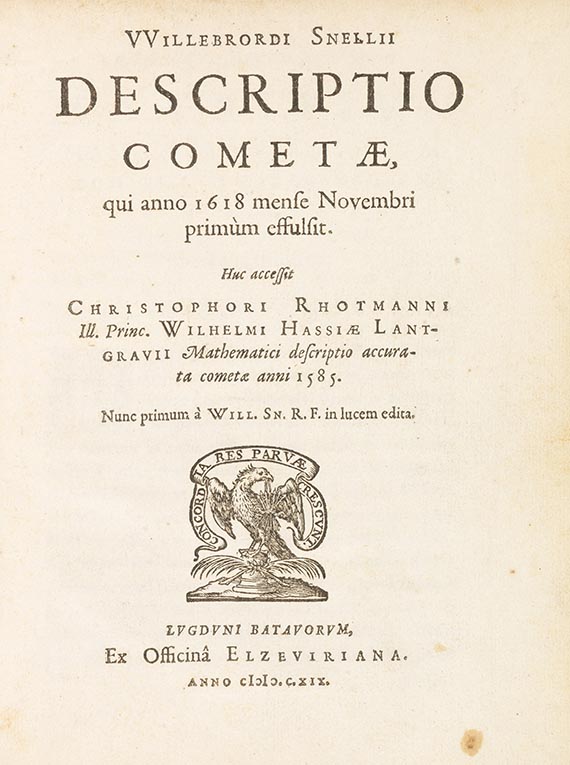Weitere Abbildung
Weitere Abbildung
37
Willebrord Snellius
Descriptio cometae, 1619.
Schätzung:
€ 1.500 Ergebnis:
€ 4.750 (inkl. Käuferaufgeld)
Der schreckliche Winterkomet von 1618
Willebrord Snellius
Descriptio cometae, qui anno 1618 mense Novembri primum effulsitt. Huc accessit Chr. Rhotmanni descriptio accurate cometae anni 1585. Leiden, Elzevir 1619.
- Seltene Kometenbeschreibung des bedeutenden Astronomen Willebrord Snellius
- Prophezeiung des Dreißigjährigen Krieges
- Mit Beschreibung des ersten durch ein Teleskop beobachteten Kometen
Erste und einzige Ausgabe dieser seltenen Kometenschrift von Snellius, der mit Johannes Kepler und Tycho Brahe in Verbindung stand. "Snel published some observations by Bürgi and Tycho in 1618, and his descriptions of the comets of 1585 and 1618, published in 1619, show Snel to be a follower of the Ptolemaic system. Although he demonstrated from the parallax that the comet was beyond the moon and therefore could not consist of terrestrial vapors, he still believed in the character of comets as mina" (DSB). - Snellius' Zeitgenossen sahen den Schweifstern als Prophezeiung des Dreißigjährigen Krieges an. Im Jahre 1618 wurden mehrere Kometen beobachtet, die zum sog. "Ulmer Kometenstreit" führten. Hier ging es um die Frage, ob die Kometen, die im Jahre 1618 beobachtet wurden, Zeichen des Zorns Gottes waren und Krieg, Tod und Elend ankündigten, oder ob es sich nur um natürliche Erscheinungen ohne jeglichen Einfluss handelte. Auch Johannes Kepler beschreibt einen der Kometen in De cometis libelli tres, erschienen 1619 in Augsburg. - Zur Beoachtung des Kometen von 1585 durch den Astronomen Christoph Rothmann siehe Cat. Weil XIX, Nr. 289: "C. Rothmann, astronomer to the Landgrave of Hesse, made very correct observations fo the comet of 1585, and a correspondence on these observations with Tycho Brahe still exists. Rothmann's dates were first published by Snellius together with his observations of the 1618 comet, the famous star on which Kepler wrote his De Cometis Libellis tres , and which was the first comet observed with a telescope (by J. B. Cysat of Lucerne)".
EINBAND: Pergamentband der Zeit mit handschriftlichem Rückentitel. 20,5 : 16 cm. - ILLUSTRATION: Mit Holzschnitt-Titelvignette und 9 Holzschnitt-Diagrammen im Text. - KOLLATION: 4 Bll., 156 S. - ZUSTAND: Vereinzelt fleckig, insges. gutes und sauberes Exemplar. - PROVENIENZ: Privatsammlung Norddeutschland.
LITERATUR: Bierens de Haan 4393. - Libri Rari 260. - Willems 165. - Berghman 639. - DSB XII, 500. - Honeyman 2866. - Weil Kat. 19, 289. - Siehe ausführlich die Veröffentlichung von A. Bähr Der grausame Komet. Hamburg 2017.
Rare comet description by the renowned astronomer Willebrord Snellius, with a prophecy of the Thirty Years' War and a description of the first comet observed through a telescope. Contemp. parchment with hand-lettered spine. With woodcut title vignette and 9 woodcut diagrams in the text. 4 ll., 156 pp. - Isolated stains, all in all fine and clean copy.
Willebrord Snellius
Descriptio cometae, qui anno 1618 mense Novembri primum effulsitt. Huc accessit Chr. Rhotmanni descriptio accurate cometae anni 1585. Leiden, Elzevir 1619.
- Seltene Kometenbeschreibung des bedeutenden Astronomen Willebrord Snellius
- Prophezeiung des Dreißigjährigen Krieges
- Mit Beschreibung des ersten durch ein Teleskop beobachteten Kometen
Erste und einzige Ausgabe dieser seltenen Kometenschrift von Snellius, der mit Johannes Kepler und Tycho Brahe in Verbindung stand. "Snel published some observations by Bürgi and Tycho in 1618, and his descriptions of the comets of 1585 and 1618, published in 1619, show Snel to be a follower of the Ptolemaic system. Although he demonstrated from the parallax that the comet was beyond the moon and therefore could not consist of terrestrial vapors, he still believed in the character of comets as mina" (DSB). - Snellius' Zeitgenossen sahen den Schweifstern als Prophezeiung des Dreißigjährigen Krieges an. Im Jahre 1618 wurden mehrere Kometen beobachtet, die zum sog. "Ulmer Kometenstreit" führten. Hier ging es um die Frage, ob die Kometen, die im Jahre 1618 beobachtet wurden, Zeichen des Zorns Gottes waren und Krieg, Tod und Elend ankündigten, oder ob es sich nur um natürliche Erscheinungen ohne jeglichen Einfluss handelte. Auch Johannes Kepler beschreibt einen der Kometen in De cometis libelli tres, erschienen 1619 in Augsburg. - Zur Beoachtung des Kometen von 1585 durch den Astronomen Christoph Rothmann siehe Cat. Weil XIX, Nr. 289: "C. Rothmann, astronomer to the Landgrave of Hesse, made very correct observations fo the comet of 1585, and a correspondence on these observations with Tycho Brahe still exists. Rothmann's dates were first published by Snellius together with his observations of the 1618 comet, the famous star on which Kepler wrote his De Cometis Libellis tres , and which was the first comet observed with a telescope (by J. B. Cysat of Lucerne)".
EINBAND: Pergamentband der Zeit mit handschriftlichem Rückentitel. 20,5 : 16 cm. - ILLUSTRATION: Mit Holzschnitt-Titelvignette und 9 Holzschnitt-Diagrammen im Text. - KOLLATION: 4 Bll., 156 S. - ZUSTAND: Vereinzelt fleckig, insges. gutes und sauberes Exemplar. - PROVENIENZ: Privatsammlung Norddeutschland.
LITERATUR: Bierens de Haan 4393. - Libri Rari 260. - Willems 165. - Berghman 639. - DSB XII, 500. - Honeyman 2866. - Weil Kat. 19, 289. - Siehe ausführlich die Veröffentlichung von A. Bähr Der grausame Komet. Hamburg 2017.
Rare comet description by the renowned astronomer Willebrord Snellius, with a prophecy of the Thirty Years' War and a description of the first comet observed through a telescope. Contemp. parchment with hand-lettered spine. With woodcut title vignette and 9 woodcut diagrams in the text. 4 ll., 156 pp. - Isolated stains, all in all fine and clean copy.
37
Willebrord Snellius
Descriptio cometae, 1619.
Schätzung:
€ 1.500 Ergebnis:
€ 4.750 (inkl. Käuferaufgeld)

Ihre Lieblingskünstler im Blick!
- Neue Angebote sofort per E-Mail erhalten
- Exklusive Informationen zu kommenden Auktionen und Veranstaltungen
- Kostenlos und unverbindlich


 Lot 37
Lot 37 
